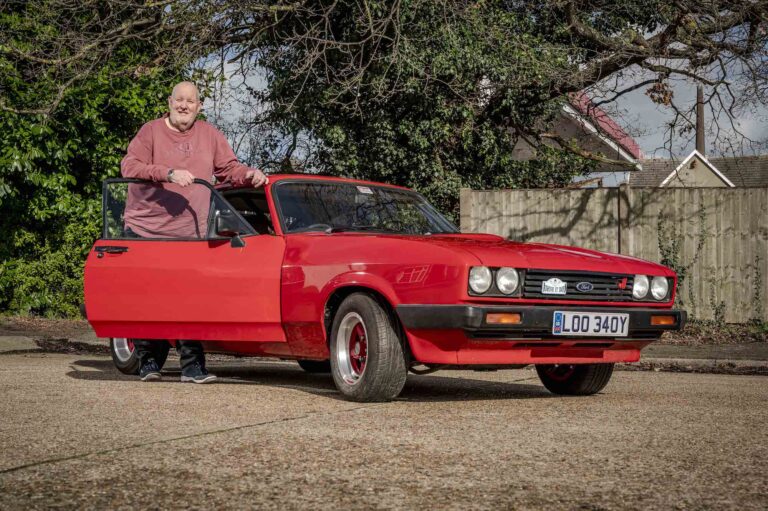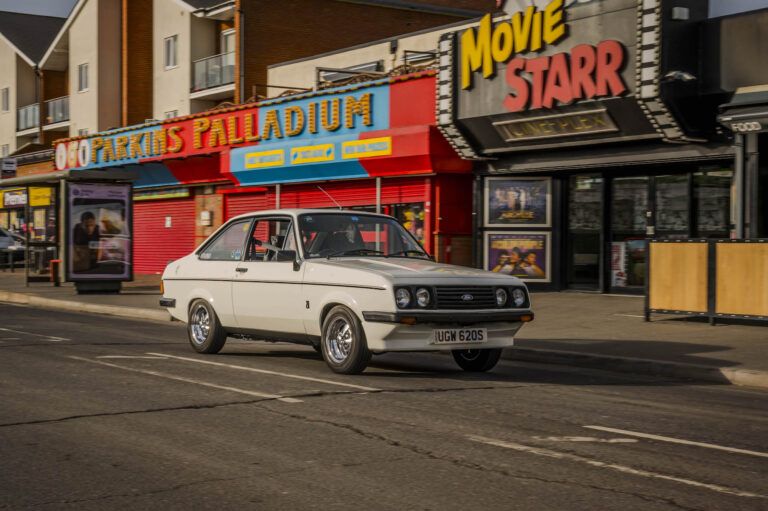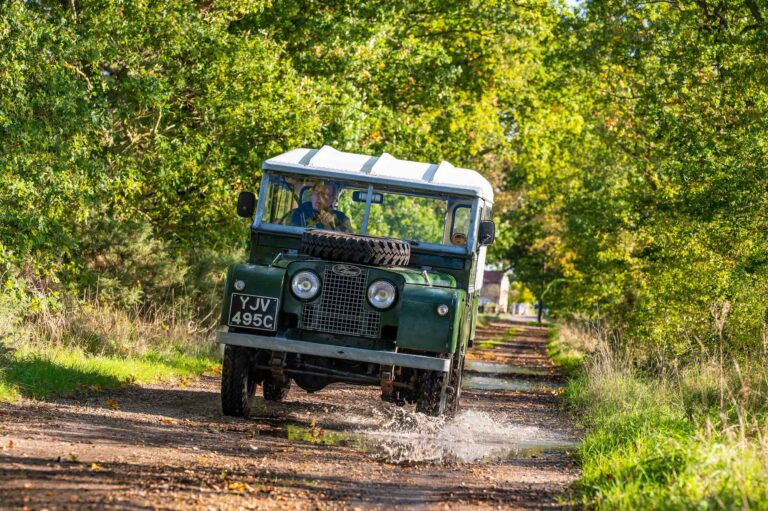To John Spong, his unrestored 1956 VW Beetle is far more than just a car; it’s a treasured time machine that opens a window to the remarkable life of his late Uncle George and an unlikely wartime love affair.
Having survived the trenches and prison camps of the first world war, John’s uncle was persuaded to buy a Beetle – rather than a British Morris – by his son-in-law, a young German soldier who fell in love with George’s daughter while held prisoner in England during World War Two.
Awkwardly, George was working for Morris in Oxford at the time, and for years had to keep his car a secret from his bosses and colleagues, riding to work on a bicycle.
On his retirement in 1964, George sold the car to his nephew for £225, and John has owned it ever since, winning a host of concours awards over the years and keeping the rare oval Beetle in immaculate original condition – as well as giving it the fitting registration plate 1956 VW.
Now 80, John has already earmarked grandson Mark – a self-employed motorsport expert and racing driver – to take on the responsibility of keeping the Beetle in the family.
“He’s the ultimate destination for the Beetle without any doubt,” says John. “He will get my car and will treat it with the respect that his grandad would be grateful for.”
The only time John came close to selling the Beetle was when he lost his driving licence because of deteriorating eyesight in 2014.
It caused a rebellion in my family
“Two or three guys were really keen to buy it,” he says. “It caused a rebellion in my family. I’ve got three daughters and there was an outcry against dad selling it. They said ‘if you had a Rembrandt or a Picasso you would have it on a wall to look at. Keep the car, open the garage door, look at it, make sure it’s running, shine it up etc.’
“So I kept it and I’m lucky to still have it after 53 years. If anything happened to it now I’d be devastated.”
The remarkable story of the VW Beetle is well-documented – Hitler’s pre-war “people’s car” only survived into post-war production because an unexploded bomb lodged among irreplaceable equipment in the factory at Wolfsburg was safely removed by the British army.
The factory and tooling should have been dismantled, but no British car manufacturer was interested, reports stating that “it is quite unattractive to the average buyer…to build the car commercially would be a completely uneconomic enterprise”.
How wrong they were, with more than 20 million rolling off the production lines since the first post-war Type 1s (as they were then known) were commissioned for the British army – all painted in khaki, of course.
Although John’s Beetle, with the trusty 1192cc, flat-four, air-cooled engine, wasn’t manufactured until 11 years after hostilities ended, the story of how it came into the Spong family is firmly rooted in war.
John’s father and his older brother, Uncle George, were working at their uncle’s motor tyre shop on Shaftesbury Avenue in London when George was detained by National Service registration officers shortly after his 18th birthday.
READ MORE ABOUT SOME OF OUR GREATEST CLASSIC CARS WITH

A series of articles on our Cult Classics site.
The horror of trench warfare
This was August 1916, two years into the war and just months after the introduction of compulsory conscription for men under 51.
Within days, George was facing the horror of trench warfare in northern France.
“Subjected to unthinkable shelling, my uncle and one colleague became isolated, sole survivors of a group previously dozens strong,” says John, from Wanstead in East London.
“On their own, they realised that whatever trench they travelled they could arrive in a friendly or enemy dug-out. Their option took them to a huddle of sheltering German soldiers, all wounded and fearful of being shot.
“My uncle and his pal chose to use their wound dressing supplies to aid their enemies. Still aware of their predicament, they became resigned to the fact that whichever country’s troops arrived first, they faced either death or return to the front line.”
As it turned out, the first troops to the dug-out near Cambrai were German, but an astonishing coincidence ensured that George’s life was spared, and he would serve 18 months as a prisoner of war.
“A young German officer smiled as he greeted my uncle and spoke in perfect English – the pair recognised each other, possibly from the tyre shop, and that’s probably what prevented him from being shot there and then,” says John.
Word was sent to George’s parents that he was missing, presumed dead, but a year later he was discovered at a prisoner of war camp by an International Red Cross inspection and, after the Armistice, made his way home.
Of course, war was to devastate Europe again a little over 20 years later, and John’s father and uncle were bombed out of London and decamped to Oxford.
Too old to serve, they were given designated jobs, George recycling salvaged metals and components from crashed aircraft at Morris Motors.
By 1945, as the end of the war in Europe drew closer, it was common for German prisoners of war to be seen working the fields around Oxford, and given special permission to attend dances in town in the evenings.
At one such dance, George’s teenage daughter met a 17-year-old boy called John and asked her parents if she could invite him home for tea.
“She didn’t mention that he was a German prisoner of war, captured in France, and sent to work in agriculture in Oxford during day release from a low security compound,” says John.
A daughter openly courting a German
“My uncle’s dilemma was how to reconcile the anguish of his own wartime experiences, plus a son battling the Japanese in Burma, and a daughter openly courting a German. He need have no fears – harmony prevailed and two years later my uncle had a German son-in-law.”
After the war, and with George still working at Morris and entitled to a discount on a new car, he began discussing with the family which model to buy.
But there was one dissenting voice – a young German who knew all about the cars from his homeland.
“He said ‘you are mad! You know how poor the quality of the steel is’,” says John. “‘You tell us how paint is sprayed over rained-on bodywork. You will be wasting your money dad, go and have a look in that German car dealer and just feel the metal and look at the paint and how the car is assembled – it’s well worth the extra money in the long run.’”
Ten years after hostilities ended, George and his family accompanied his son-in-law to Germany for the first time, over Christmas and New Year.
“John’s family lived in Kaiserslautern in the French zone of occupied West Germany, and he’d been too terrified of going home because there was still a lot of ill-feeling there towards German soldiers,” says John.
81.5% of customers could get a cheaper quote over the phone
Protect your car with tailor-made classic car insurance, including agreed value cover and discounts for limited mileage and owners club discounts

My uncle fell in love with the Beetle
“But it was there my uncle fell in love with the Beetle, visiting a dealer and leaving highly impressed and with a German language brochure in hand, which I still have.”
Back in Oxford, George headed straight for VW dealer Humphris and put a deposit on a jungle green De Luxe type 114 from Wolfsburg.
“My dad, somewhat amused, said ‘you’ll never guess what your uncle has bought – one of those German cars with the engine at the back’,” says John, back home for a break from his own National Service.
“Whenever I saw my uncle with his car, it was always immaculate. He had a garage built and never put the car away wet, it was always covered under a cotton dust-sheet.
“There was tongue-in-cheek complaint that the first real failure of the car to perform was the death of the only English component, the Exide battery, after seven years.
“My uncle continued to work at Morris but, aware of small-minded attitudes prevailing in Cowley, he never drove to work nor broadcast his ownership of an imported German car.”
After eight years and 33,000 miles, and with George set to retire from Morris at the age of 66, he announced during a hospital visit to John’s sick mother that he was selling the car.
“He said ‘you won’t see the car after today. I’m selling the Beetle’,” remembers John, who was back living and working in east London.
“He seemed almost as grief stricken as he was at the passing of my mum. This was to be the final trip in what he always called the “Folkswagen”, as Morris had obliged him to retire on his 66th birthday two weeks later.
“I said ‘that’s a shame, who’s bought it? I would have loved to buy that off you’. Within a few seconds I’d bought it off him for £225. I had never, ever sat in a VW, let alone driven one.
He almost shed tears of joy
“He almost shed tears of joy and it was instantly agreed that the Beetle would stay in the family.”
The Beetle replaced John’s rapidly rusting Austin A30, and was the sole family car for a number of years, attending and winning concours awards at VW shows around the country, and taking in European tours covering Belgium, Holland, Luxembourg, and Germany.
John was hooked, and the car proved as reliable for him as it had his uncle George.
“My youngest daughter was born three months after we bought the Beetle and she still smiles at the threat we used to make that if times got hard and someone had to leave, it was ‘last in, first out’, hence she’d have to go before the Beetle!” says John, who followed his father into the rubber trade.
“It’s utterly reliable – it just goes on and on and on.”
Oval Beetles, denoting the shape of the rear window, are relatively rare, but those in unrestored condition like John’s are like hen’s teeth – the only changes from when it rolled off the production line are two resprayed wings and the addition of indicators.
“In the very first year, I had somebody whack one of the wings outside Buckingham Palace,” says John.
“I took it to a VW garage in Plaistow and when I was in there getting an estimate for the front offside wing it got hit on the other wing! I had both resprayed and apart from that it’s totally original.”
Anyone who’s ever owned a Beetle will know the sense of camaraderie from fellow Dub fans on the road, and John says: “I’ve made so many friends through owning a Beetle.
“My wife and I were on our way back from an overnight stay in the Midlands with the kids in the car.
READ MORE ABOUT SOME OF OUR GREATEST CLASSIC CARS WITH

A series of articles on our Cult Classics site.
You make friends all over the place
“The girls wanted to use the toilet, so we pulled into a layby with some toilets. Before they came out two other VW owners had stopped and said ‘are you all right?’ They thought I’d broken down. You don’t get that with any other car – you make friends all over the place.”
Beetles soon became John’s passion, and he “always had a VW I was taking to pieces to save bits”.
“Word got around and one day someone phoned me up and said ‘did you save that 25hp engine you had? I’m on the A13 and my crankshaft’s gone’.
“I took the engine out to him, with tools and a trolley jack. I changed his engine by the road, and less than three-quarters of an hour later he was off with my old engine in his car.”
When out and about, the biggest talking point on the car is its number plate, 1956 VW, complete with an “oh yes it is” strapline.
The car was originally registered 241 AFC, before John spotted an advert in Exchange and Mart for a Beetle bearing the perfect plate.
“I saw a 1959 Beetle with a few weeks tax and MoT for sale for £60,” says John who, after leaving the rubber industry, went on to work as a battery expert and then a breakdown driver.
“I never even saw the car, and transferred the registration onto my 1956 VW the day before the MoT on the new purchase expired. The vendor kept the car and, as far as I know, scrapped it for a few extra quid.
“It generates a lot of interest. People say ‘look at that number plate’. They ask if it is and I say “oh yes it is”, so I got it written on the plate.”
With the family grown up, a Sunbeam Tiger took over as John’s daily driver, with the Beetle laid up between 1981 and 2011, when it was recommissioned for the road by Dubz-by-Dan, near Braintree.
Remarkably, all the car needed to pass its first MoT for 30 years was a fresh battery and new brake hydraulics.
“Danny was astounded at the condition of my car,” says John. “He’d been judging Volkswagen concours events for 10 years or so and he said he’d never seen an unrestored Beetle anywhere near as good.
“It’s a testament to the build quality at Wolfsburg and shows that the mid 50s was the high-point of quality for the factory.
Clatter clatter bang bang and it fires into life
“I know now if I went into the garage, turned the key, gave a couple of pumps on the accelerator, an inch on the choke, clatter clatter bang bang and it fires into life.”
The interior of the car is in astonishing condition given its vintage, while the original paintwork and badges bear their own unique patina of age.
These days, the Beetle attracts more attention than ever when grandson Mark visits to take John for a drive or to a local show.
“If and when it’s on the road people stand and look,” says John. “Recently at a show there was a row of cars, a Lotus Elite that looked immaculate, a TVR, Austin 7, Rolls Royce, and a mark 2 Jag. A couple of times my grandson stood back and took photos and there were 15 or 20 people milling around my car, and one or two looking at the others.
“Young girls come up to me and say ‘my grandad used to have one of those.’”
John has lived in the same street in Wanstead for 50 years, and the Beetle has been there with him throughout, from the days when lamplighters would still attend to the gas street lights at dawn and dusk to the modern era of low emissions zones and soaring London property prices.
And, with Mark ready to keep the car in the family for many years to come, there’s plenty of life in the old Bug yet.
Uncle George would be very proud.



